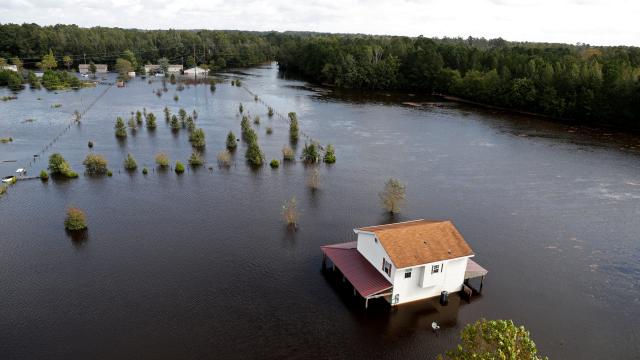One of the things you can count on in the wake of a hurricane making landfall is people clamoring for a new classification system. Like clockwork, that’s what’s happening with Florence. And frankly, the discussion has never been more urgent thanks to climate change.
After rapidly intensifying into a Category 4 beast, Florence slowly decayed until it landed in the Carolinas as a Category 1 storm. It was degraded further over the course of the weekend to a tropical storm and then a depression. All of these changes were based on one factor: How strong the maximum winds were.
The idea that our sole way of defining hurricanes is by winds is supremely misguided. Some meteorologists hate it. Many people are confused by it. For storms that take a major human toll, it seems especially wrong-footed given that water is responsible for 90 per cent of all deaths according to 2016 research. It’s like if Madden ratings where only based on a player’s ability to run (sorry Tom Brady).
And with a storm like Florence, it’s easy to see why we need a new scale. The winds did a small portion of the damage while historic rainfall has created a flooding crisis that’s still unfolding. Storm surge—which was driven by Florence’s huge wind field and not just peak winds—further damaged the coast. Some people ignored evacuation orders because the storm was continually downgraded until landfall. Our current ranking system is literally putting people in danger.
But that’s not even the worst part. Climate change is clearly intensifying the rainfall and surge associated with storms, making the Saffir Simpson scale even more out of synch with the hazards people living in hurricane zones face.
The heaviest downpours are getting heavier thanks to climate change for a simple reason: A warmer atmosphere can hold more water. When that water falls out, look out below. The heavy rains from Florence and Harvey as well as what we saw recently with Lane in Hawaii exemplify that trend. In Harvey’s case, it was second-most costly hurricane on record with much of that rain falling over one of the largest cities in the U.S. Research published earlier this year indicates that hurricanes will get wetter still.
Then there’s the storm surge part. Thanks again to climate change, oceans are rising. Seas have climbed about a foot since record keeping began. That gives storm surge a huge lift to inundate areas further inland.
The costliest hurricane in U.S. history was Katrina (a Category 3 at landfall), which did most of its damage from storm surge. Ditto for Hurricane Sandy (Category 1) and Hurricane Irma (Category 3 at landfall in Florida), which are also among the five most destructive hurricanes. Like Florence, those storms has massive wind fields that also allowed them to stir up more of the ocean. And also like Florence, they got a lift from sea level rise. Sandy’s surge wouldn’t have done nearly as much damage to New York’s subway system, for example, if it weren’t for the extra sea level rise boost. Future storm surge will only be worse and it won’t take a Sandy-level storm to inundate New York.
In fact, the only hurricane on the top five list that did beaucoup damage from wind is Maria. That speaks to a lot of things, notably the how slow the federal response was. That points to how we need to improve how and where we build, but it doesn’t alter the changing calculus of climate change and its influence on the storms themselves.
Now look, the Saffir Simpson scale has a great back story. It came into existence in 1971 owing to the efforts of Herbert Saffir, a wind engineer, and Bob Simpson, the head of the National Hurricane Center. Their goal was the give the public a better sense of the risks hurricanes pose. And the scale originally focused on the impact of winds on cheap buildings like mobile homes. You could argue there’s a little bias since Saffir was a wind guy, but to be fair this was also progressive thinking given that it’s inevitably the poor that suffer the most from storms.
But with climate change set to make poor people’s lives even worse (to say nothing of the rest of us as well), Saffir’s namesake scale needs to be redrawn. And we should do it soon so people get out of harm’s way before the pig shit hits the fan.
